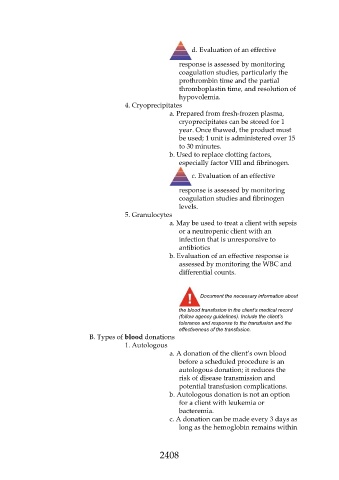Page 2408 - Saunders Comprehensive Review For NCLEX-RN
P. 2408
d. Evaluation of an effective
response is assessed by monitoring
coagulation studies, particularly the
prothrombin time and the partial
thromboplastin time, and resolution of
hypovolemia.
4. Cryoprecipitates
a. Prepared from fresh-frozen plasma,
cryoprecipitates can be stored for 1
year. Once thawed, the product must
be used; 1 unit is administered over 15
to 30 minutes.
b. Used to replace clotting factors,
especially factor VIII and fibrinogen.
c. Evaluation of an effective
response is assessed by monitoring
coagulation studies and fibrinogen
levels.
5. Granulocytes
a. May be used to treat a client with sepsis
or a neutropenic client with an
infection that is unresponsive to
antibiotics
b. Evaluation of an effective response is
assessed by monitoring the WBC and
differential counts.
Document the necessary information about
the blood transfusion in the client’s medical record
(follow agency guidelines). Include the client’s
tolerance and response to the transfusion and the
effectiveness of the transfusion.
B. Types of blood donations
1. Autologous
a. A donation of the client’s own blood
before a scheduled procedure is an
autologous donation; it reduces the
risk of disease transmission and
potential transfusion complications.
b. Autologous donation is not an option
for a client with leukemia or
bacteremia.
c. A donation can be made every 3 days as
long as the hemoglobin remains within
2408

